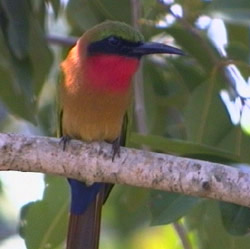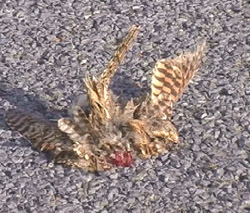birdtours.co.uk
Birdwatching Trip Reports from the Gambia
|
birdtours.co.uk |
|
Unfortunately, the Bird Safari Camp still has only 7 rooms and with a large party already booked into those rooms later in the week, we could only spend the two nights there. A great pity as we had quickly realised what a superb birding area it was in, and also it meant another long day spent mainly in the vehicle if we were to visit Basse for the Egyptian Plover and also to see the Red Throated Bee-eaters and then to travel back to Tendaba Camp for the next two nights.
An early start of course, and we were in Basse by mid morning and delighted to find that Egyptian Plovers were still there. These smart looking birds only visit for a few months at the end of the rainy season and the frequent the most run-down grubby part of what is probably the most untidy town in the Gambia. How they manage to keep looking so smart in this environment is a mystery, but, living on the edge of the town as they do, they are relatively approachable, which helps when taking photographs.

We crossed to the north bank of the river after a pleasant half watching the plovers to where another new lodge with accommodation is being built. It wasn't finished when we were there, but it looked relatively smart and could prove to be a good stopping off spot for those wanting to spend time well up river. Again I was hopeful of finding the elusive Shining Blue Kingfisher but again it was not to be. We were treated to fine views of Red Throated Bee-eaters which were in the trees all around us.

We travelled further east along the river to where another tributary joined the river Gambia in the hopw of finding something unusual, but by now it was the middle of the afternoon and most birds had done the sensible thing and gone and hidden in the undergrowth. Relcutantly, therefore, we set off on our journey back towards Tendaba. A short stop at the nesting site of the Red Throated Bee-eaters, where we also saw little green Bee-eaters and we were then looking at another late arrival.
My previous visits to the Gambia have invariably been in the middle of the rains, or in February in the middle of the dry season. I had been singularly unsuccessful, therefore, in seeing much in the way of nightjars which commonly rest on the warm roads in the period shortly after dark. This time we were to see many in the road in our headlong rush back to Tendaba and were unfortunate enough to hit one slow to move Standard Winged Nightjar. This was not the way that I wanted to get close views. Its unfortunate, but they do experience a very high mortality on the road between Soma and Basse judging by the numbers of bodies that we passed during the day.
